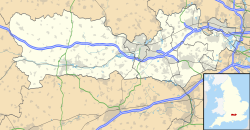| Douai Abbey | |
|---|---|
 | |
| 51°24′33″N1°10′19″W / 51.409185°N 1.171846°W | |
| OS grid reference | SU5770468214 |
| Location | Woolhampton, Berkshire |
| Country | United Kingdom |
| Denomination | Roman Catholic |
| Website | www.douaiabbey.org.uk |
| History | |
| Status | Monastery |
| Founded | 1615 |
| Founder(s) | Dom Gabriel Gifford |
| Dedication | St Edmund the Martyr |
| Dedicated | 1933 |
| Events | 1615 Founded in Paris 1818 Moved to Douai |
| Architecture | |
| Functional status | Active |
| Heritage designation | Grade II* |
| Designated | 10 November 1980 |
| Architect(s) | J Arnold Crush |
| Style | Gothic Revival |
| Groundbreaking | 1903 |
| Completed | 1993 |
| Administration | |
| Province | Southwark |
| Diocese | Portsmouth |
| Deanery | West Berkshire |
| Clergy | |
| Bishop(s) | Rt Rev Philip Egan |
| Abbot | Rt Rev Paul Gunter OSB |
Douai Abbey is a Benedictine Abbey at Upper Woolhampton, near Thatcham, in the English county of Berkshire, situated within the Roman Catholic Diocese of Portsmouth. Monks from the monastery of St. Edmund's, in Douai, France, came to Woolhampton in 1903 when the community left France as a result of anti-clerical legislation. The abbey church is listed Grade II* on the National Heritage List for England. [1]




